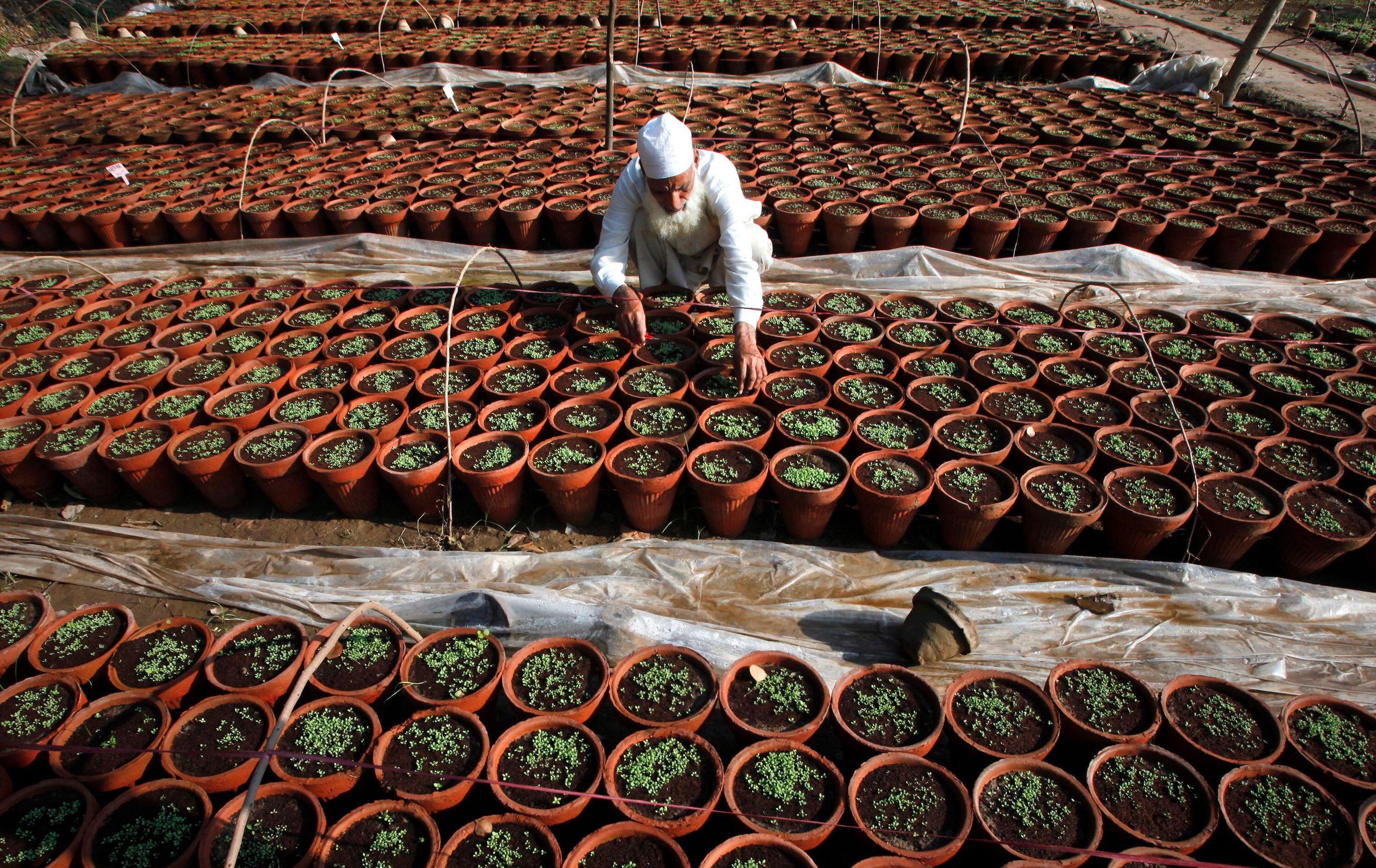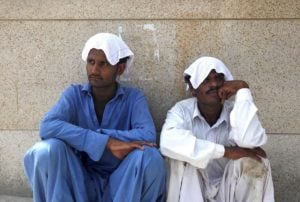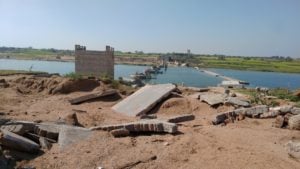Wajahat Shah, 32, is a labourer at a government-run tree plantation, spread over 3,000 hectares of army land in Pakistan’s Khyber Pakhtunkhwa province. “Ten days after the government announced the lockdown due to coronavirus, I had to close my grocery shop,” Shah told The Third Pole.
The plantation is part of the Ten Billion Tree Tsunami Programme, the flagship initiative of the recently ousted Pakistan Tehreek-e-Insaf (PTI) government. The project has been a lifesaver for up to 85,000 residents like Shah, Mohammad Usman Khan, a forest officer, said.
Before Covid-19, Shah earned as much as 25,000 Pakistani rupees (USD 129) a month from his shop. Now, his work at the plantation gives him PKR 15,000 (USD 77), and he also receives a small monthly rent from his shop, which is being run by someone else.
“I know this is much less, but our family of three has fewer needs [now]; I also prefer working outdoors,” he said, adding that this way he gets time to study for his bachelor’s degree.
However, forest officer Khan admitted that turning 3,000 hectares of barren army land into an oasis, growing olive, ziziphus lotus, rosewood, acacia trees and more, is too big a task for the 50 labourers the plantation employs. The government’s hands, he explained, were tied due to lack of funds.
The area – 32 kilometres from Peshawar, the capital of Khyber Pakhtunkhwa – has plenty of water, with groundwater drawn from solar-powered tubewells, but not enough manpower. “We should have at least eight labourers for every 40 hectares,” said Khan, adding that it may not be possible to green the area without more staff.
A ‘booster dose’ for conservation
Pakistan’s Green Stimulus, a USD 120 million loan from the World Bank, was conceived as a “booster dose” for this and similar nature-based projects, said former minister for climate change, Malik Amin Aslam, using a Covid-19 analogy.
The money, originally earmarked for a project by the Pakistan Meteorological Department, was redirected to nature restoration in response to hardship created by Covid-19, Aslam said.
Speaking to The Third Pole on 29 April following Imran Khan’s removal as prime minister, he said he feared the package may face delays.
These “nature-positive funds” Aslam said, referring to the Green Stimulus package, were “literally within arm’s reach”, with the first tranche to be released by 15 April. “The first phase was ready for rollout – when we ourselves got prematurely rolled out!” he rued.
Pakistan’s Green Stimulus was to provide jobs centred around restoring nature within the framework of the four-year Ten Billion Tree Tsunami Programme, which started in 2019.
Managing and protecting Pakistan’s 45 national parks would provide up to 6,000 jobs for park rangers. In addition, the community wardens at three national parks who had been waiting to be paid their wages since 2019 would finally be paid.
Protecting existing mangroves and planting on 50,000 hectares in the coastal belt, one of the projects slated to be supported through the Green Stimulus, was also to create employment. By the time the projects were due to take off, 150,000 people were due to find jobs from the scheme. New projects including beekeeping, and olive and avocado plantations were to be introduced.
Pakistan’s Green Stimulus fits within the scope of the UN Decade on Ecosystem Restoration 2021–2030, a framework focused on reversing ecosystem loss to fight the climate crisis. It “was meant to protect nature and give green jobs to thousands of people including youth and women”, Aslam explained.
Now with Pakistan in political turmoil, Aslam feared that “all efforts to protect nature and give green jobs may well go down the drain”.
New minister wants to continue Pakistan’s Green Stimulus
Aslam’s concerns may be unfounded. Sherry Rehman, the new climate change minister, told The Third Pole that the grant will remain available to Pakistan. The World Bank, she explained, is supporting the country, not a particular administration under a certain party, so the agreement still stands.
The Third Pole contacted the World Bank about the status of the loan; a reply had not been received at the time of publication.
The Ministry of Climate Change would like to continue with [the Green Stimulus] initiative and adopt any course correction in future if necessarySherry Rehman, Pakistan’s minister for climate change
According to the agreement, a body called the National Disaster & Risk Management Fund will receive the funds and distribute them to various departments. Eleven projects have already been vetted and approved by the bank.
“The MoCC [Ministry of Climate Change] would like to continue with [the Green Stimulus] initiative and adopt any course correction in future if necessary,” Rehman said.
Upon taking office, however, she was expecting the ministry to be more than “a single project implementation department” dedicated solely to planting trees.
“[The MoCC] is essentially a policy ministry, not a project implementation department,” she pointed out, detailing her vision of the climate change ministry, which includes policy design, monitoring provinces and engaging internationally with the global community to press Pakistan’s case as a low net polluter.
But above all, Rehman said, “[the ministry] needs Pakistan to engage in a public conversation on conservation and climate goals through state and community action”.
Pakistan has been put in a “commitment trap” where, at the international level, “it has promised far more than it can even measure, let alone deliver”Sherry Rehman, Pakistan’s minister for climate change
She noted the absence of a climate communication cell at the ministry, as well as the fact that the federal secretary’s post remains vacant. And when it comes to gender, she added, “institutional frameworks in Pakistan are inadvertently designed to preserve inequity”.
The Climate Council, a forum where representatives for the provinces meet to discuss and cooperate on frameworks for climate action, has been dormant with not a single meeting held in the past four years, she added. “All this needs to change,” she said.
Acknowledging that Rehman would have a “good idea” of the country’s needs and priorities on the climate front, Aslam cautioned that “implementation and focus” require political ownership and the understanding and backing needed at the highest level “may be missing in this administration”.
Domestic reform is the new priority
Aslam said adopting the “two-pronged approach of using clean energy transition and nature-based solutions” is essential. Reversing targets set by the previous government, he warned, will not only have ecological but economic and social consequences that Pakistan can ill afford.
He said he hoped the present government “can comprehend this and take the logical way forward towards climate compatible development”.
However, Rehman commented that she worried that Pakistan has been put in a “commitment trap” where, at the international level, “it has promised far more than it can even measure, let alone deliver”.
“While commitments to lower emissions were made abroad, no infrastructure or institutional reform was attempted at home for a genuine energy transition,” she pointed out.
And despite the “existential” nature of the crisis, no awareness was built either at a policymaking or a community level. “No work or public messaging on water deficits were made,” said Rehman, even though Pakistan will be water-scarce by 2025, according to the UN. “It seems that climate solutions have been reduced to tree plantation only.”









